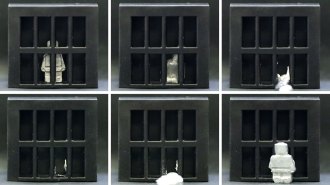Physics
Sign up for our newsletter
We summarize the week's scientific breakthroughs every Thursday.
-
 Climate
ClimateAn incendiary form of lightning may surge under climate change
Relatively long-lived lightning strikes are the most likely to spark wildfires and may become more common as the climate warms.
By Nikk Ogasa -
 Physics
PhysicsThe standard model of particle physics passed one of its strictest tests yet
An experiment with a single electron, trapped for months on end, produced one of the most precise tests yet of the standard model of particle physics.
-
 Quantum Physics
Quantum PhysicsGoogle’s quantum computer reached an error-correcting milestone
A larger array of quantum bits outperformed a smaller one in tests performed by Google researchers, suggesting quantum computers could be scaled up.
-
 Animals
AnimalsGlassy eyes may help young crustaceans hide from predators in plain sight
Nanospheres in the eye reflect light that matches the color of the surrounding water, possibly making the animals invisible to nearby predators.
-
 Physics
PhysicsHere’s why icicles made from pure water don’t form ripples
A new study explains why icicles made from pure water have irregular shapes rather than the ripples typical of the salty icicles found in nature.
-
 Physics
PhysicsPhysicists stored data in quantum holograms made of twisted light
Light that travels in corkscrew-like paths provides a way to make holograms that store large amounts of data in ultrasecure packages.
-
 Physics
PhysicsWater is weird. A new type of ice could help us understand why
A newfound type of amorphous ice with a density close to liquid water could help scientists make sense of water’s quirks.
-
 Physics
PhysicsMuon scanning hints at mysteries within an ancient Chinese wall
Density fluctuations within the ancient rampart encircling the city of Xi’an could be defects or yet-to-be-discovered archaeological finds.
-
 Materials Science
Materials ScienceThese shape-shifting devices melt and re-form thanks to magnetic fields
Miniature machines made of gallium embedded with magnetic particles can switch between solid and liquid states.
-
 Materials Science
Materials ScienceWant a ‘Shrinky Dinks’ approach to nano-sized devices? Try hydrogels
Patterning hydrogels with a laser and then shrinking them down with chemicals offers a way to make nanoscopic structures out of many materials.
-
 Chemistry
ChemistryThese chemists cracked the code to long-lasting Roman concrete
Roman concrete has stood the test of time, so scientists searched ruins to unlock the ancient recipe that could help architecture and climate change.
-
 Physics
PhysicsA powerful laser can redirect lightning strikes
In a mountaintop experiment, a laser beamed into the sky created a virtual lightning rod that snagged several bolts before they hit the ground.